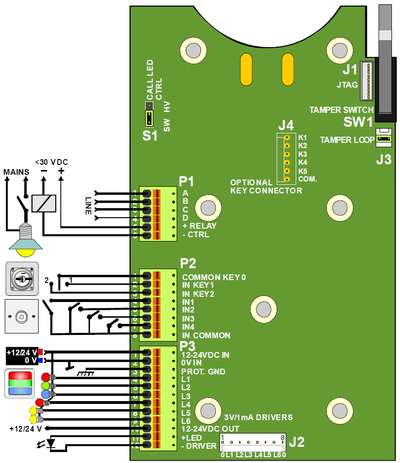PrisCom Station Connections
From Zenitel Wiki
Contents
External connections
- All external connections are terminated in the plug-in terminal blocks P1, P2 and P3.
- The spring loaded terminals can accept cable dimensions from 0.14 to 0.5 mm2 (0.16 – 0.8 mmØ , AWG 28-20).
- Single treaded cables >0.2 mm2 (0.5 mmØ) can be pushed directly into the spring connectors without the use of tools. For smaller dimensions or multi threaded cables, the red spring release buttons must be pushed during insertion.
- Dismantle 8 mm of the cables before insertion.
Optional connections
J1 - JTAG
A station programming connector which is used during production only.
J2 - 3V/1mA DRIVERS
An 8-pin IDC connector carrying the general purpose outputs L1 – L6 as 3V/1mA signals which may be used for connection to the STENTOFON MRBD relay card. For other purposes the ELCON 42080 plug should be used.
J3 - TAMPER LOOP
A 2-pin IDC connector in series with the station tamper switch. The pins are shorted by a jumper as default. External NC tamper switches may be connected to this terminal by using an ELCON 42050 plug.
J4 - OPTIONAL KEY CONNECTOR
The J4 connector is normally not mounted in stations delivered with original front panel. If the station PCB is used with a custom made front panel, the buttons can be terminated to a 6-pin IDC connector.
- - Mount and solder a PCB pin header ELCON 42610 in the J4 space.
- - Use an ELCON 42060 plug to connect desired buttons. Max cable length is 150 mm.
- K1 CELL LIGHT
- K2 CALL BUTTON
- K3 PROGRAM SELECTOR
- K4 VOLUME UP
- K5 VOLUME DOWN
- COM. COMMON RETURN WIRE
S1 – CALL LED CONTROL
The jumper is used to select between hardware or software controlled station-on LED.
- HW - LED is always on when the microphone is powered. It is impossible to listen-in without LED indication.
- SW - LED on or off according to software programming (default). This is normally same function as the HW setting.
<u<Intercom Line
The cell stations are connected in a normal AlphaCom star wiring system using 2 pair twisted 0.5 or 0.6 mmØ (AWG 24) cable. The maximum cable length is as for display stations.
- P1 (1&2): A/B Pair - Audio and data from exchange
- P1 (3&4): C/D Pair - Audio and dialing tones from station
Local Power
A local power (other than the line power) is used for the signal and group lamps and the free general outputs. This power is also used for the LED segments in the display.
- - The local power is not needed if none of the general outputs are used.
- - A common 12 or 24 VDC power source is normally used for all stations in the same area.
- - It is recommended to connect the local power negative pole to ground.
- - The consumption per station is normally 0.5 – 2 A depending on type and number of connected lamps.
- - The voltage at the station board must not be less than 9V which means a maximum voltage drop of 15V at 24V supply and 3V at 12V.
IMPORTANT NOTICE: P3/3 must be connected to local mains earth. Static discharges may cause noise and station malfunction!
- P3 (1) - 12-24 VDC IN Local power+
- P3 (2) - 0V IN Local power-
- P3 (3) - PROT.GND Protective earth for the station front
- P3 (10) - 12-24 VDC OUT Power output for local relays etc. P3 / 10
NOTE that this output is NOT fused!

